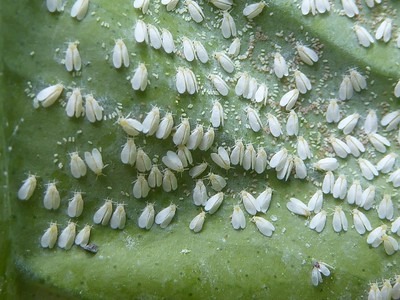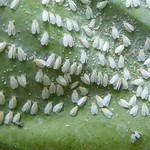
GM/Biotech Crops Report – March 2022
1st March 2022- GM/Biotech Crops Monthly Reports (BELOW) form part of BCPC’s free three-tier Biotech Crops Info service.
- This service also includes a weekly round-up of news from around the globe – see BCPC Newslink GM Crops section.
- Plus – Free access database on over 300 GM/biotech products covering 23 crops in the global market visit BCPC’s GM/Biotech Crops Manual – Register here for free access.
- Already registered? Click here
GM/Biotech Crops Monthly Report March 2022
You are what you eat
 Whiteflies contain numerous genes that they have derived from the plants that they eat. These genes are fully functioning and are used to code RNA that helps detoxify some of the toxins that the plant manufactures to deter feeding by whitefly! Disrupting these genes could offer new ways of controlling this pest. Pic: Epitree.
Whiteflies contain numerous genes that they have derived from the plants that they eat. These genes are fully functioning and are used to code RNA that helps detoxify some of the toxins that the plant manufactures to deter feeding by whitefly! Disrupting these genes could offer new ways of controlling this pest. Pic: Epitree.
Full Story.
Gene therapy to the rescue
Every year around four babies are born in the UK with an hereditary disorder, Metachromatic Leukodystrophy (MLD), where a faulty gene fails to produce an essential enzyme. The condition is progressive leading to failing nerve and brain function but now gene therapy can replace the faulty gene and potentially allow a normal life. The treatment will be available on the NHS and it is thought that other hereditary diseases may be treated with this technique.
Full story
Cure for sickle cell anaemia
Mutated haemoglobin causes red blood cells to distort and they do not flow easily through blood vessels. Now a team in America has used gene editing on stem cells that they have then inserted in to a sufferer’s bone marrow and once the damaged red blood cells have been purged from the blood system they are replaced by undistorted red blood cells containing normal haemoglobin.
Full Story.
Zero cancer in children
Australia has embarked upon a programme to eradicate cancer deaths in children by giving them targeted treatments. Samples of the tumour are genetically sequenced and then drugs are screened to specifically target these tumours. The programme is reporting good rates of success with this approach.
Full Story
Crops grown under red plastic
Crops appear green because they reflect the blue and yellow parts of the spectrum and absorb the red light to power their chlorophyll. Now a team at Western Sydney University in Australia have developed a pigment that absorbs the blue and yellow wavelengths of light and emits it as red light. Some crops grown under a mesh containing this pigment have shown a 37% increase in biomass but the quality and flavour of the increased yield has yet to be evaluated.
Full Story
Crops that make their own nitrogen
The cost of nitrogen fertiliser has shot up recently but the University of Florida is investigating ways of replicating the nitrogen-fixing nodules of legumes in other crop species.
Full Story
Reduced lodging risk in oilseed rape
Scientists at Calgary University have used CRISPR-Cas9 editing to generate a shorter oilseed rape crop that naturally is less likely to lodge before harvest.
Full Story
Virus-resistant Phaseolus beans
Researchers in Brazil have developed new bean varieties by conventionally breeding across GM lines to produce varieties that are resistant to BCMV, BGMC and CPMMV that are transmitted by whitefly. The new varieties are high yielding and also help suppress the transmission of other viruses in the crop.
Full Story
Increased wheat yields
Researchers at University of California, Davis have identified a gene that delays the formation of the terminal spike in wheat plants. The delay results in a larger terminal spike with more room for an increased number of grains and so could result in increased yields.
Full Story
Mildew-resistant wheat
The Chinese Academy of Science have used multiple CRISPR-Cas9 editing to produce a wheat that has robust resistance to diseases such as powdery mildew with no adverse effects on growth habit or final yields.
Full Story
Soybeans resistant to cyst nematodes
Scientists at the Jilin Academy for Agricultural Sciences have developed a GM soybean that is resistant to the damage caused by cyst nematodes – one of the biggest causes of yield loss in soybeans globally.
Full Story
Rothamsted modifies Camelina
Rothamsted has already modified Camelina to produce omega-3 fatty acids but now that have gone a stage further and modified to produce vinyl phenols that are normally obtained from fossil fuels and are an important component in a range of plastics including PVC and mobile phone screens.
Full Story
THE LATEST ADDITIONS TO THE GM/BIOTECH DATABASE ARE:
The latest approvals of biotech crops to report this month:
• MS11 x RF3 – new stacked event – Oilseed rape tolerant of glufosinate approved for environmental use in Australia.
• MS11 x RF3 x MON88302– new stacked event – Oilseed rape tolerant of glufosinate and glyphosate approved for environmental use in Australia
FOR INSTANT ACCESS TO GM BIOTECH MANUAL CLICK HERE (Registration required)
Already Registered? Click here to access

